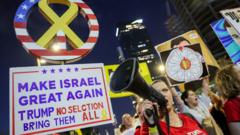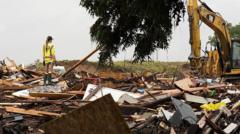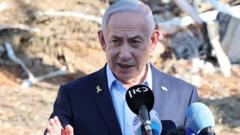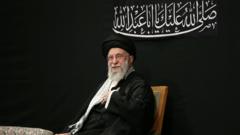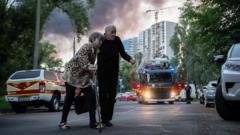The second round of nuclear talks between Iran and the US reveals a complex interplay of diplomacy, military threats, and public sentiment, as both sides attempt to navigate the precarious landscape towards a potential agreement, despite calls for a clear resolution and ongoing tensions.
Nuclear Diplomacy: Iran and the US Navigate Talks Amid Military Tensions

Nuclear Diplomacy: Iran and the US Navigate Talks Amid Military Tensions
As negotiations between Iran and the US resume in Rome, both parties face a backdrop of military threats and conflicting statements, complicating hopes for a nuclear deal.
In a significant development, Iran and the United States have reconvened for a second round of nuclear negotiations in Rome, signaling a tentative step towards de-escalation. Both nations are set to meet again next week, although optimism is tempered by an atmosphere filled with military threats and mixed signals. President Donald Trump has maintained a steady reminder to Tehran, alternating between the prospect of a diplomatic resolution and the looming threat of military action, including a potential Israeli strike on Iranian nuclear facilities.
Amid these negotiations, Trump expressed a preference for diplomatic engagement over military confrontation, stating, "I think that Iran has a chance to have a great country... if there's a second option, I think it would be very bad for Iran." This rhetoric comes on the heels of the first round of discussions held in Oman, which both sides described as constructive; however, Trump indicated that he would soon be making crucial decisions regarding Iran's nuclear ambitions.
The ongoing tensions stem from Trump's 2018 withdrawal from the landmark 2015 nuclear agreement, which had imposed limitations on Iran's nuclear activities in exchange for sanctions relief. Since the US' exit, Iran has incrementally breached these restrictions, increasing its stockpile of highly-enriched uranium, an act they state is not indicative of intentions to develop nuclear weapons. Concurrently, the Iranian government asserts that its return to the negotiating table did not stem from fear of the US or Israeli strikes, but rather a focused approach from the US on nuclear issues alone.
Despite this, skepticism remains regarding the potential for a breakthrough agreement. The US envoy to the Middle East, Steve Witkoff, emphasized that any final arrangement must dismantle Iran's nuclear enrichment and weaponization program. In a contradiction, he had also suggested that Iran could continue enriching uranium within certain limits, leading Iranian Foreign Minister Abbas Araghchi to highlight the need for clarity in negotiations, stating that the principle of enrichment itself is non-negotiable.
The negotiations occur amid a whirlwind of diplomatic activities, including a recent visit from Saudi Arabia’s Defense Minister to Tehran, as both countries engage in broader regional conversations. The backdrop of military readiness on both sides adds another layer of complexity, with Iran warning that any military action could elicit retaliation against US bases in the region. This sentiment reflects the ongoing apprehension within Iran regarding its national security and the fallout from heightened military engagement.
The portrayal of the talks from both sides indicates divergent narratives; while the US claims the discussions are direct, Iran emphasizes a mediated approach involving Oman. Public perception in Iran is also crucial, as demonstrated by the positive sentiment following announcements of constructive exchanges, showcasing a public eager for economic relief and stability amid difficult living conditions.
In sum, while the diplomatic talks offer a glimmer of hope, the mix of military threats, public discontent, and mixed communications illustrate that many hurdles remain before a resolution can be reached. With historical distrust influencing the negotiations, both nations tread carefully on the path toward potential disarmament and diplomatic relations restoration. The road ahead is fraught with complexity, with the stakes as high as ever for the involved parties and the broader region.
Amid these negotiations, Trump expressed a preference for diplomatic engagement over military confrontation, stating, "I think that Iran has a chance to have a great country... if there's a second option, I think it would be very bad for Iran." This rhetoric comes on the heels of the first round of discussions held in Oman, which both sides described as constructive; however, Trump indicated that he would soon be making crucial decisions regarding Iran's nuclear ambitions.
The ongoing tensions stem from Trump's 2018 withdrawal from the landmark 2015 nuclear agreement, which had imposed limitations on Iran's nuclear activities in exchange for sanctions relief. Since the US' exit, Iran has incrementally breached these restrictions, increasing its stockpile of highly-enriched uranium, an act they state is not indicative of intentions to develop nuclear weapons. Concurrently, the Iranian government asserts that its return to the negotiating table did not stem from fear of the US or Israeli strikes, but rather a focused approach from the US on nuclear issues alone.
Despite this, skepticism remains regarding the potential for a breakthrough agreement. The US envoy to the Middle East, Steve Witkoff, emphasized that any final arrangement must dismantle Iran's nuclear enrichment and weaponization program. In a contradiction, he had also suggested that Iran could continue enriching uranium within certain limits, leading Iranian Foreign Minister Abbas Araghchi to highlight the need for clarity in negotiations, stating that the principle of enrichment itself is non-negotiable.
The negotiations occur amid a whirlwind of diplomatic activities, including a recent visit from Saudi Arabia’s Defense Minister to Tehran, as both countries engage in broader regional conversations. The backdrop of military readiness on both sides adds another layer of complexity, with Iran warning that any military action could elicit retaliation against US bases in the region. This sentiment reflects the ongoing apprehension within Iran regarding its national security and the fallout from heightened military engagement.
The portrayal of the talks from both sides indicates divergent narratives; while the US claims the discussions are direct, Iran emphasizes a mediated approach involving Oman. Public perception in Iran is also crucial, as demonstrated by the positive sentiment following announcements of constructive exchanges, showcasing a public eager for economic relief and stability amid difficult living conditions.
In sum, while the diplomatic talks offer a glimmer of hope, the mix of military threats, public discontent, and mixed communications illustrate that many hurdles remain before a resolution can be reached. With historical distrust influencing the negotiations, both nations tread carefully on the path toward potential disarmament and diplomatic relations restoration. The road ahead is fraught with complexity, with the stakes as high as ever for the involved parties and the broader region.

